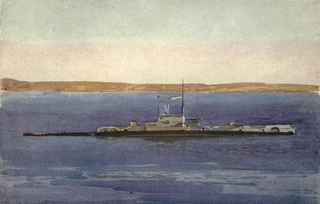
HMS E11 was an E-class submarine of the Royal Navy launched on 23 April 1914. E11 was one of the most successful submarines in action during the 1915 naval operations in the Dardanelles Campaign, sinking over 80 vessels of all sizes in three tours of the Sea of Marmara.

HMS Seahorse was a first-batch S-class submarine built for the Royal Navy during the 1930s. Ordered in March 1931, she was laid down at Chatham Dockyard in September 1931 and launched on 15 November 1932.

SMS Cöln was a Kolberg-class light cruiser of the German Kaiserliche Marine during the First World War. She had three sister ships, SMS Kolberg, Mainz, and Augsburg. She was built by the Germaniawerft in Kiel; her hull was laid down in 1908 and she was launched in June 1909. Cöln was commissioned into the High Seas Fleet in June 1911. She was armed with a main battery of twelve 10.5 cm SK L/45 guns and had a top speed of 25.5 kn. After her commissioning, she served with the II Scouting Group, part of the reconnaissance forces of the High Seas Fleet.
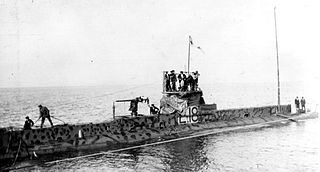
HMS E18 was an E-class submarine of the Royal Navy, launched in 1915 and lost in the Baltic Sea in May 1916 while operating out of Reval. The exact circumstances surrounding the sinking remain a mystery. The wreck of the submarine was discovered in October 2009.
HMS L10 was a L-class submarine built for the Royal Navy during World War I. The boat was sunk in 1918 by German torpedo boats.

HMS E3 was the third E-class submarine to be constructed, built at Barrow by Vickers in 1911-1912. Built with compartmentalisation and endurance not previously achievable, these were the best submarines in the Royal Navy at the start of the First World War. She was sunk in the first ever successful attack on one submarine by another, when she was torpedoed on 18 October 1914 by U-27.

HMS Hogue was a Cressy-class armoured cruiser built for the Royal Navy around 1900. Upon completion she was assigned to the Channel Fleet and the China Station. In 1906 she became a training ship for the North America and West Indies Station before being placed in reserve in 1908. Recommissioned at the start of World War I, she played a minor role in the Battle of Heligoland Bight a few weeks after the beginning of the war. Hogue was sunk by the German submarine U-9, together with two of her sister ships, on 22 September 1914.

HMS D2 was one of eight D-class submarine built for the Royal Navy during the first decade of the 20th century.
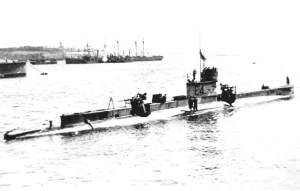
HMS E4 was a British E class submarine built by Vickers, Barrow-in-Furness, costing £101,900. E4 was laid down on 16 May 1911, launched on 5 February 1912 and commissioned on 28 January 1913. On 24 September 1915 E4 was attacked by the German airship SL3. On 15 August 1916, she collided with sister ship E41 during exercises off Harwich. Both ships sank and there were only 14 survivors, all from E41. Both boats were raised, repaired and recommissioned. She was sold on 21 February 1922 to the Upnor Ship Breaking Company.

HMS E5 was a British E-class submarine built by Vickers Barrow-in-Furness. She was laid down on 9 June 1911 and was commissioned on 28 June 1913. She cost £106,700. E5 was sunk, probably by striking a mine, on 7 March 1916.

HMS E6 was a British E-class submarine built by Vickers Barrow-in-Furness. She was laid down on 12 November 1911 and was commissioned on 17 October 1913. She cost £106,900.

HMS E7 was a British E class submarine built at Chatham Dockyard. She was laid down on 30 March 1912 and was commissioned on 16 March 1914. She cost £105,700.

HMS E8 was a British E-class submarine built at Chatham Dockyard. She was laid down on 30 March 1912 and was commissioned on 18 June 1914. She cost £105,700. During World War I, she was part of the British submarine flotilla in the Baltic.
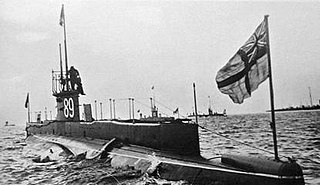
HMS E9 was a British E class submarine built by Vickers, Barrow. She was laid down on 1 June 1912 and was commissioned on 18 June 1914.

The Active-class cruisers were a trio of scout cruisers built for the Royal Navy shortly before the First World War. They were initially assigned to the First Fleet and became destroyer flotilla leaders in 1914. Amphion and Fearless and their flotillas were assigned to the Harwich Force when the war began in August 1914. They went out on a patrol on the first day of the war and Amphion and her destroyers encountered and sank a German minelayer. On the voyage home, the cruiser struck a mine laid by the German ship and sank. She was the first ship of the Royal Navy to be sunk in the war.
HMS E16 was an E-class submarine built by Vickers, Barrow-in-Furness for the Royal Navy. She was laid down on 15 May 1913 and was commissioned on 27 February 1915. Her hull cost £105,700. E16 was the first E-class to sink a U-boat, U-6, sunk 4 mi (6.4 km) south-west of Karmøy island off Stavanger, Norway on 15 September 1915. E16 was sunk by a mine in Heligoland Bight on 22 August 1916. There were no survivors.
HMS E49 was an E-class submarine built by Swan Hunter, Wallsend for the Royal Navy. She was laid down on 15 February 1915 and was commissioned on 14 December 1916. E49 was mined off the Shetland Islands on 12 March 1917. The minefield was laid by the German U-boat UC-76 on 10 March 1917. There were no survivors. E49 lies 96 ft (29 m) down with her bows blown off.
HMS E32 was a British E class submarine built by J. Samuel White, Cowes, Isle of Wight. She was launched on 16 August 1916 and commissioned in October 1916. HMS E32 was sold in Sunderland on 6 September 1922.
HMS E47 was an E-class submarine launched by Fairfield, Govan for the Royal Navy and completed by William Beardmore, Dalmuir. She was launched on 29 May 1916 and was commissioned in October 1916.
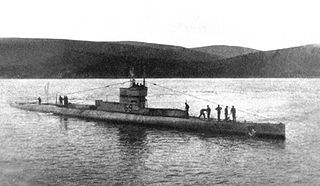
HMS G8 was a G-class submarine of the Royal Navy that saw service during World War I, costing an estimated £125,000.
















